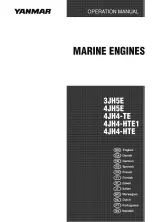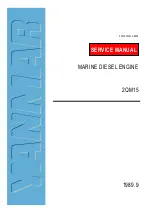
2 - G
ENERAL
I
NFORMATION
18
90-8M0098854 MARCH 2015
S
AFE
B
OATING
S
UGGESTIONS
In order to safely enjoy the waterways, familiarize yourself with local
and other governmental boating regulations and restrictions, and
consider the following suggestions.
Use flotation devices.
Have an approved personal flotation device
of suitable size for each person aboard (it is the law) and have it
readily accessible.
Do not overload your boat.
Most boats are rated and certified for
maximum load (weight) capacities (refer to your boat capacity plate).
If in doubt, contact your dealer or the boats manufacturer.
Perform safety checks and required maintenance
. Follow a
regular schedule and ensure that all repairs are properly made.
Check safety equipment onboard.
Here are suggestions of the
types of safety equipment to carry when boating:
•
Approved fire extinguisher; paddle or oar.
•
Signal devices: flashlight, rockets or flares, flag and whistle or
horn.
•
Spare propeller, thrust hubs and an appropriate wrench.
•
Tools for necessary minor repairs; first aid kit and book.
•
Anchor, extra anchor line; waterproof storage containers.
•
Manual bilge pump and extra drain plugs; compass and map
or chart of area.
•
Spare operating equipment; batteries, bulbs, fuses, etc.
•
Transistor radio and drinking water.
Know signs of weather change and avoid foul weather and
rough
‑
sea boating.
Tell someone where you are going and when you expect to
return.
Know and obey all nautical rules and laws
of the waterways
.
Boat operators should complete a boating safety course. Courses
are offered in the U.S.A. by:
1. The U.S. Coast Guard Auxiliary
2. The Power Squadron
3. The Red Cross
4. Your state boating law enforcement agency
Direct all inquiries to the Boat U.S. Foundation information number
1‑800‑336‑BOAT (2626).
We strongly recommend that all powerboat operators attend one of
these courses.
You should also review the NMMA Sources of Waterway
Information booklet. It lists regional sources of safety, cruising and
local navigation and is available at no charge by writing to:
Sources of Waterway Information
National Marine Manufacturers Association
410 N. Michigan Avenue
Chicago, IL 60611 U.S.A.
Make sure everyone in the boat is properly seated
. Do not allow
anyone to sit or ride on any part of the boat that was not intended for
such use. This includes the back of seats, gunwales, transom, bow,
decks, raised fishing seats, any rotating fishing seat; or anywhere
that an unexpected acceleration, sudden stopping, unexpected loss
of boat control, or sudden boat movement could cause a person to
be thrown overboard or into the boat.
Never be under the influence of alcohol or drugs while boating
(it is the law)
. Alcohol or drug use impairs your judgment and
greatly reduces your ability to react quickly.
Summary of Contents for Racing 1100 STERNDRIVE
Page 7: ...ii 90 8M0098854 MARCH 2015...
Page 27: ...2 GENERAL INFORMATION NOTES 20 90 8M0098854 MARCH 2015...
Page 43: ...5 CONDITIONS AFFECTING OPERATION NOTES 36 90 8M0098854 MARCH 2015...
Page 63: ...6 MAINTENANCE NOTES 56 90 8M0098854 MARCH 2015...
Page 71: ...8 OWNER SERVICE ASSISTANCE NOTES 64 90 8M0098854 MARCH 2015...
















































